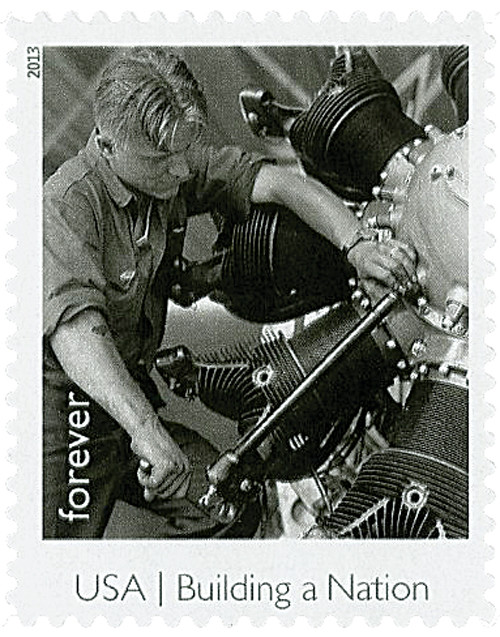
# 4801k - 2013 First-Class Forever Stamp - Made in America: Textile Worker
US #4801k
2013 Textile Worker – Made in America
- One of 12 stamps celebrating the industrial workers who brought America into a new age
Stamp Category: Commemorative
Set: Made in America
Value: 46¢ First Class Mail Rate (Forever)
First Day of Issue: August 8, 2013
First Day City: Washington, D.C.
Quantity Issued: 2,500,000
Printed by: Avery Dennison
Printing Method: Photogravure
Format: Panes of 12
Why the stamp was issued: To honor textile workers and the way they helped change the clothing industry.
About the stamp design: Pictures a black and white vintage photograph by Lewis Hines of a textile worker on the job.
First Day City: The First Day of Issue Ceremony was held at the Frances Perkins Building, part of the Department of Labor in Washington, DC.
About the Made in America set: Includes 12 different stamp designs picturing black and white vintage photographs of male and female industrial workers. Eleven were taken by photographer Lewis Hine, with the twelfth by Margaret Bourke-White. The USPS said “Stamps are like a miniature American portrait gallery. They are an expression of our values and a connection to our past. That’s why it’s so fitting that this series depicts Americans at work. These iconic images tell a powerful story about American economic strength and prosperity. These men and women and millions like them really did build a nation.”
History the stamp represents: Mill owner Sidney Blumenthal once said, “The priceless ingredients of things sold in the market places are the honor and integrity of those who make them.” In 1932 and 1933, photographers Lewis Hine captured the dignity of textile workers in Blumenthal’s Shelton Looms.
During this era, bales of cotton were transformed into cloth in New England textile mills. After being cleaned, the cotton was processed into yarn. Workers with titles like “doffers” and “spoolers” replaced filled bobbins and tied broken threads.
In the weave room, a warper threaded each strand into the “creel,” or frame, of the loom. The shuttle then passed back and forth through the warp threads creating a pattern as the fabric took shape.
Many of the workers came from rural farms to work in the mills. Their lives were governed by the factory whistles, which signaled the beginning and end of 10- to 12-hour days and short lunch breaks. The work was hard and the wages were low, but the workers were glad to have jobs during the Great Depression.
Rather than showing the power and technology of America’s factories, Hine’s photos highlighted the vital work of those who operated the machines and produced affordable goods to be used throughout the US and beyond.
US #4801k
2013 Textile Worker – Made in America
- One of 12 stamps celebrating the industrial workers who brought America into a new age
Stamp Category: Commemorative
Set: Made in America
Value: 46¢ First Class Mail Rate (Forever)
First Day of Issue: August 8, 2013
First Day City: Washington, D.C.
Quantity Issued: 2,500,000
Printed by: Avery Dennison
Printing Method: Photogravure
Format: Panes of 12
Why the stamp was issued: To honor textile workers and the way they helped change the clothing industry.
About the stamp design: Pictures a black and white vintage photograph by Lewis Hines of a textile worker on the job.
First Day City: The First Day of Issue Ceremony was held at the Frances Perkins Building, part of the Department of Labor in Washington, DC.
About the Made in America set: Includes 12 different stamp designs picturing black and white vintage photographs of male and female industrial workers. Eleven were taken by photographer Lewis Hine, with the twelfth by Margaret Bourke-White. The USPS said “Stamps are like a miniature American portrait gallery. They are an expression of our values and a connection to our past. That’s why it’s so fitting that this series depicts Americans at work. These iconic images tell a powerful story about American economic strength and prosperity. These men and women and millions like them really did build a nation.”
History the stamp represents: Mill owner Sidney Blumenthal once said, “The priceless ingredients of things sold in the market places are the honor and integrity of those who make them.” In 1932 and 1933, photographers Lewis Hine captured the dignity of textile workers in Blumenthal’s Shelton Looms.
During this era, bales of cotton were transformed into cloth in New England textile mills. After being cleaned, the cotton was processed into yarn. Workers with titles like “doffers” and “spoolers” replaced filled bobbins and tied broken threads.
In the weave room, a warper threaded each strand into the “creel,” or frame, of the loom. The shuttle then passed back and forth through the warp threads creating a pattern as the fabric took shape.
Many of the workers came from rural farms to work in the mills. Their lives were governed by the factory whistles, which signaled the beginning and end of 10- to 12-hour days and short lunch breaks. The work was hard and the wages were low, but the workers were glad to have jobs during the Great Depression.
Rather than showing the power and technology of America’s factories, Hine’s photos highlighted the vital work of those who operated the machines and produced affordable goods to be used throughout the US and beyond.








